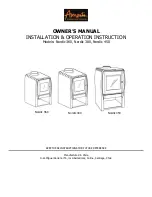
To make the heater burn for a long period fill with large pieces of dry hardwood, open the air control fully and burn
briskly for a few minutes to get the logs alight. The best setting for slow burning is with the air control fully closed. After
an extended combustion cycle, reset the fire by stirring the live coal under the ashes and add some sticks and small logs.
Slide the air control to the fully open position and allow the fireplace temperature recover before adding larger logs.
RAPID BURNING
To obtain maximum heat from your AMESTI firstly establish the fire and then leave it running with the top air control
open fully. Keep an eye on your stove when you do this as with a good flue draft and dry wood it is possible for the stove
to glow red hot.
Burning the fire with the top air control and bottom air control fully open will often not give the hottest fire as too much
heat is lost up the flue and so does not come into the room. Similarly running the stove with the door open will not
produce maximum heating in the room as the stove will draw a lot of warmed air out of the room.
MAINTENANCE
1.
Removing the Ashes – Depending on the type of wood burned, the ashes will need removing every 2 to 6 weeks.
With a small shovel, push the hot coals to one side and shovel most of the ash into a metal bucket. Leave a small
bed of ash to retain the coals and insulate the base of the firebox. The fire burns the ashes extremely finely so
cover the bucket and take care not to stir up the ashes too much-
2.
Cleaning Paint Work and Glass – The stove, when cool, can be cleaned with a damp cloth. Over the years the
black will fade and should be touched up with high temperature stove paint. We do not recommend graphite
based stove polish. To clean the glass we recommend cleaning with a damp cloth. Avoid using any abrasive
material that could scratch it.
3.
Door Seal – The door seal is a 12,7mm round fiberglass braided rope. If it should need replacing fix it in its
groove with silicone mastic.
4.
Fire Bricks - The bricks should last many years, but if any need replacing they can be placed in position vertically
and are held in place at the top by the angle brick retainer.
5.
Chimney Cleaning - The frequency with which the chimney will need cleaning will depend on the way that the
heater has been used as well as the type and dryness of the wood burned. Keep an eye on the flue passages and
if there appears to be a buildup of soot is time to clean the flue. To get at the flue form inside the stove, remove
the smoke shelf from under the flue.
WARNING!
1.
THE APPLIANCE AND FLUE-SYSTEM SHALL BE INSTALLED IN ACCORDANCE WITH AS/NZS2918 AND THE
APPROPRIATE REQUIREMENTS OF THE RELEVANT BUILDING CODE OR CODES.
2.
APPLIANCE INSTALLED IN ACCORDANCE WITH THIS STANDARD SHALL COMPLY WITH THE REQUIREMENTS OF
AS/NZS4013 WHERE REQUIRED BY THE RECULATORY AUTHORITY, I.E. THE APPLIANCE SHALL BE
IDENTIFIABLE BY A COMPLIANCE PLATE WITH THE MARKING “TESTED TO AS/NZS 4013”.
3.
ANY MODIFICATION OF THE APPLIANCE THAT HAS NOT BEEN APPROVED IN WRITING BY THE TESTING
AUTHORITY IS CONSIDERED TO BE IN BREACH OF THE APROVAL GRANTED FOR COMPLIANCE WITH AS/NZS
4013.
4.
MIXING OF APPLIANCE OR FLUE - SYSTEM COMPONENTS FROM DIFFERENT SOURCES OR MODIFYING THE
DIMENSIONAL SPECIFICATION OF COMPONENTS MAY RESULT IN HAZARDOUS CONDITIONS. WHERE SUCH
ACTION IS CONSIDERED, THE MANUFACTURER SHOULD BE CONSULTED IN THE FIRST INSTANCE.
5.
CRACKED AND BROKEN COMPONENTS, e.g. GLASS PANELS OR CERAMIC TILES, MAY RENDER THE
INSTALATION UNSAFE.
6.
DO NOT USE FLAMMABLE LIQUIDS OR AEROSOLS TO START OR REKINDLE THE FIRE.
7.
DO NOT USE FLAMMABLE LIQUIDS OR AEROSOLS IN THE VICINITY OF THIS APPLIANCE WHEN IT IS
OPERATING.
8.
DO NOT STORE FUEL WITHIN HEATER INSTALLATION CLEARANCES.
9.
OPEN AIR CONTROL BEFORE OPENING FIRING DOOR.
10.
THIS APPLIANCE SHOULD NOT BE OPERATED WITH CRECKED GLASS.
11.
THIS APPLIANCE SHOULD BE MAINTAINED AND OPERATED AT ALL TIMES IN ACCORDANCE WITH THESE
INSTRUCTIONS.
12.
THE USE OF SOME TYPES OF PRESERVATIVE-TREATED WOOD AS A FUEL CAN BE HAZARDOUS.

























